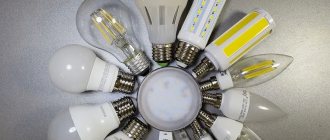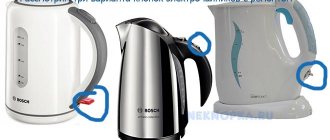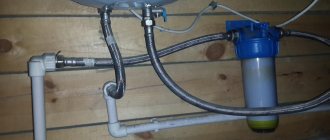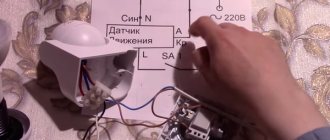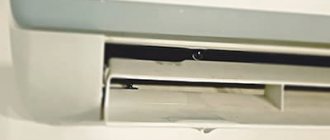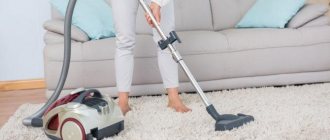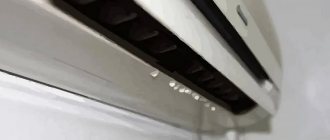If the thermopot slowly pumps water or stops supplying it altogether, this indicates that certain parts are clogged or broken. The most common cause is a malfunction of the pump. But you shouldn’t immediately purchase a new thermopot, because first you need to study the nature of the problem, and then you can try to fix it yourself.
Pump design in a thermopot
The pump is responsible for pumping water in the thermopot. It can be manual in the form of a pump and electric, where the impeller is driven by an electric motor. Each node differs in its structure:
- The electric pump consists of an electric motor. A plastic working chamber is mounted on its body. Inside it, water is pumped due to a rotating impeller mounted on the electric motor shaft. Some manufacturers of thermopots install a filter in front of the inlet pipe. Important! A clogged filter may be the reason why the pump of a household appliance has stopped working.
The electric pump consists of a motor and a plastic pumping chamber - The hand pump is a pump made in the form of a corrugated cylinder. All elements are made of plastic. The pump operates only with the lid tightly closed. She needs tightness. A person operates the pump. When he presses a button on the closed lid of the thermopot with his finger, the corrugated cylinder contracts. Air is forced into the upper part of the chamber. The resulting pressure pushes out a portion of water with each press of the button. The displaced liquid is directed through the pipe to the thermopot spout. When the button is released, the mechanism returns to its original position.
The hand pump is made of plastic and operates by generating air pressure inside the chamber.
Differences between a thermopot and a kettle
Thermopot device
DIY repair
It is an electrical device for heating and boiling water. Using periodic heating, it maintains the optimal temperature at a given level. It consists of heating elements - tubular water heating elements.
Features that distinguish a thermopot from an electric kettle:
- A combination of the functions of two devices - a thermos and a kettle. The device boils the liquid and turns off, maintaining the desired temperature. The water does not cool down for 8–10 hours.
- There are devices with a water heating element that heats the liquid to a set value.
- The thermos is capable of boiling a large volume of water and the temperature does not drop below 65° for 12 hours. Built-in elements consume up to 600 W per day.
Disadvantages of the device:
- Unlike a kettle, it consumes more electricity. The kettle uses it only when brewing water, and the thermo-device constantly maintains the temperature.
- Most models are equipped with filters that need to be changed every month.
- Some devices have water tanks in which the temperature of the liquid can be adjusted. The device can act as a cooler, supplying hot and cool water.
Kettle structure
When there is no need to constantly heat water, an electric kettle is the best option. It is small and consumes little energy.
Pros:
- The electric kettle is compact, convenient to take with you and move from place to place.
- Consumes current only when water is boiling. Daily energy consumption for a family of three is about 650 W.
- A few minutes are enough to get a hot drink. The thermopot heats the water longer.
Minuses:
- A mid-priced model with only a timer function and a power lock. More expensive devices may have a clock, a heating function, or a thermostat.
- In most cases, the body of the kettle gets very hot, especially the metal one. The dense walls of the thermos maintain heat without heating up.
- Consumes more than 600 W per day, while a thermopot consumes about 300.
https://youtube.com/watch?v=QZe4DunLYWo
Design and principle of operation of the thermopot
The thermopot combines the functions of a thermos and a kettle, and in some cases, a cooler. Device capacity is from 5 to 10 liters. The cost, depending on the functions, is 700–4000 rubles.
To heat the liquid to a certain temperature, each model has a stepwise or stepless type thermostat. The first regulates heating at certain temperature values, the latter - from 50 to 100°. A device with high heat resistance: 5-7 hours after boiling, the liquid will remain hot. The temperature of the electric kettle immediately after heating is 90°.
The creators have provided protection for the device from overheating by integrating a thermostat. Many models have built-in alarms, clocks and modes. The liquid in the thermos is supplied using a built-in or manual pump. The liquid boils in 20–30 minutes and remains hot for up to 15 hours.
Design and principle of operation of an electric kettle
The question of which is better, an electric kettle or a thermopot, is difficult to answer. The kettle is compact, mains powered and designed for boiling water. The volume of popular devices is 1–2 liters.
Manufacturers make life easier by equipping devices with additional characteristics: a heating function and a clock. Small kettles are not suitable for a large company. It is best to purchase a medium-sized model of 2 liters.
What is a thermopot
Thermopot is an electric kettle with a heat-saving body and a pump for supplying water and a function to maintain a set temperature. That is, it is a combined household appliance that not only boils water, but also maintains its temperature at a given level.
Thermopot is a “cross between” an electric kettle and a thermos with a pump
So, the functions of a thermopot are to heat/boil water and maintain its temperature. To reduce the cost of maintaining temperature, the housing is made with insulation. True, it is not vacuum, as in good modern thermoses, but air. So the losses are still greater than in a thermos. But this device is convenient where hot water is often needed.
This purpose is reflected in the names. Termopot is a transliteration from English termo-pot. Where termo is translated as heating, and pot is a pot or kettle. You can also find such names as heated thermos, electric thermos, thermos kettle, temperature-maintaining kettle, thermal kettle.
There are household thermopots with a capacity of 2–6 liters. There are also ones with a larger water tank, but they are usually used in cafes, restaurants, in offices, etc. To reduce the cost of maintaining the water temperature, the housing has two walls with an air gap. So even the two-liter version is quite large. Holding it and turning it over to pour water is completely inconvenient. Therefore, thermopots are equipped with pumps for supplying hot water.
The pump can be electrical or mechanical. The temperature regulator is stepped or smooth. There are also models with electronic control (buttons or touch panel). In this case, there may be a remote control.
Advantages and disadvantages
The presence of a spout makes it possible not to tilt the device to pour water. This eliminates the risk of tip-overs and hot water spills, which can cause severe burns. Thermopot provides a much higher level of safety than a kettle or thermos. This makes it indispensable for use by children, the sick and the elderly. In addition, most models are equipped with a system for blocking the water supply when accidentally pressed.
Figure 1 Thermopot. General form
Water can be boiled in advance and set to maintain the desired temperature. At the same time, energy consumption is minimal. Typically, several heating modes are supported - one hour, three, six and nine hours. This way you can prepare in advance for a coffee break during a meeting or conference, and at home boil water for the whole day during the cheap tariff.
The device also has disadvantages. Boiling water takes much longer than in a regular kettle. If the water in the flask runs out, you will again have to wait a long time for a new portion of hot water. For conferences, in this case, they usually provide several thermopots or add hot water boiled in a regular kettle to them.
Schematic diagram
If the thermopot does not work, you need to familiarize yourself with the circuit diagram.
The circuit of this device is not too complicated - even a non-professional electrician can “read” it.
It can be used to investigate the causes of failure of devices from such popular manufacturers as:
- Polaris;
- Vitek;
- Elenberg;
- Scarlett et al.
Schematic diagram
Explanation of the main symbols used in the diagram
Explanation:
- S1 and S2 are temperature switches from the KSD 302 series, the first is located in the middle of the stainless steel tank and is connected in series to transmit a supply voltage of 220 Volts, the second is located in the bottom of the thermopot - current flows through it to the main heating element;
- F1 – thermal fuse;
- TN2 is an additional water heating coil, which should be checked to answer the question why the thermopot does not maintain the temperature;
- relay S1.1 connected in parallel with the reboiling spiral;
- TN1 – spiral of the main heating element;
- VT1, VT2 – transistors on which there is a relay for controlling the on and off time, which open under the influence of a charged capacitor C3;
- C3 is an electrolytic capacitor, charged by pulses from VD6 when the S4 button is briefly pressed;
- K1 – relay winding through which electric current flows and switches S1.1;
- C1, C2, VDS1 – voltage rectifiers that supply power to the time relay circuit.
Notes:
- C1 serves as a damper for excess voltage;
- C2 – smoothes out electric current ripples resulting from the operation of the bridge rectifier VDS1;
- Some units do not use C1, but a step-down transformer.
The pump does not pump water
A common problem is that the potter stops supplying hot water. Pouring it with a ladle is an unpleasant prospect. And without water supply, the device turns into a regular electric kettle with improved thermal insulation. Repair of the thermopot in this case depends on the type of breakdown. If the pump does not turn on, there are two options - power problems or a burnt out motor. If it hums, but the water does not flow or flows with little pressure, the pump may be clogged or the impeller is faulty.
The thermopot does not pump water. It's not necessarily the pump. There can be many reasons
Eating problems
Oddly enough, the potter pump may not work due to a burnt-out heating coil. Look at the diagram. The pump is powered through this part of the heater. That is, if the potter does not pump water, the first thing we do is check to see if the temperature maintenance heater has burnt out.
Electrical circuit of a thermopot: one of the device options
If there are problems with the heating element, after replacing it the pump will start working. If replacing the heater is not an option, you can “build in” a separate power supply for the pump. You can find a charger with suitable parameters (most likely a constant voltage of 12 V is required), disassemble the case, and place the bridge and fuse somewhere in the case. You will have to resolder both the input and the voltage supply to the pump.
If the pump works but does not pump water
If the pump motor hums but no water flows, it may simply be clogged. In this case, it is necessary to disassemble the entire water supply path and rinse it from scale. It should help. Step by step steps:
- First of all, we take photos of all the parts from all sides so that we can assemble them later.
- Remove the hoses by loosening the clamps.
- Disconnect the pump, wash the hoses and remove the scale.
The thermopot pump may not pump due to scale
- We measure the windings (with a multimeter in continuity or resistance measurement mode). There should be no short circuit or open circuit (very small or infinitely large resistance). If there is one or the other, it is useless to clean the pump - you need to buy a new one.
- If the motor is intact, perhaps the reason that the electric potter does not pump water is due to scale or debris that has gotten inside the pump and is preventing the impeller from spinning. In the pump, we remove the impeller (it is held on by magnets, just pull it), clean the blades and magnet from plaque, debris, etc.
- We assemble it in reverse order, turn it on and check the operation.
Cleaning or replacing a thermopot pump is not as expensive as replacing a heating element. So this type of repair work is quite justified.
Causes of electric pump breakdowns
Important! Before you start troubleshooting, you need to take care of your safety. When disassembling the device, it should be unplugged and the hot water drained.
Common causes of malfunctions are as follows:
- Control system malfunction.
- The thermopot pump does not work.
- The impeller chamber is dirty.
If the thermopot stops supplying water, the problem is not necessarily with the pump. Before disassembling the assembly, you need to make sure that sufficient voltage is supplied to the motor contacts. This can be done with a tester (multimeter). There is another option. The motor contacts are supplied with a constant voltage of 12 volts from another source, such as a car battery. If the engine starts to rotate, there is a problem in the control system, and you need to further diagnose it.
If the device does not have a standby heating function, you should check the condition of the power supply rectifier diodes.
If there is such a function, you need to check the resistance of the pilot heating coil; it could fail (burn out). The engine is powered through it.
If the engine itself is working properly, then you can carry out minor repairs to the thermopot pump yourself.
The reasons for a hand pump not working may be the following:
- Violation of the integrity of the corrugated plastic cylinder.
- Wear of the silicone gasket of the top cover.
These faults are detected by external inspection and do not require diagnostic tools or disassembling the device. But to replace faulty parts, you will have to disassemble the thermal sweat cover in the first case, and the thermal sweat body in the second.
Frequent breakdowns of thermopots
Let's look at the most common problems and how to fix them.
- The indicator panel does not light up and the device does not function at all. In such a situation, it is necessary to inspect all wires and connections, as well as the thermostat and fuse. If there is more than one breakdown, it will be more difficult to repair the device yourself.
- Only the secondary boil key functions, but the main primary boil is not performed. In such a situation, the thermal switch located in the bottom is checked.
- The main boiling works, but during the secondary boiling, the thermopot does not work. It is necessary to inspect the module on the main board.
- Boiling does not work, only heating is available. Most likely, the heating component burned out or the wire broke.
- The water supply is not working. There are problems with the pump. Often this will burn out the auxiliary heating coil element, resulting in no voltage being supplied to the motor.
See also -
How to repair an electric kettle yourself
How to make a thermopot with your own hands from an old electric kettle?
Today, everyone can make any design with their own hands. To make a thermopot at home, you will need knowledge, time and financial investment. All internal parts can be purchased in stores or at the market. To do this, you need to buy a power board, which consists of a transformer, a diode bridge, as well as several resistors and capacitors.
From an old electric kettle that is faulty, you will need to unscrew all the screws and remove the internal parts. Instead, a block, a board and microcircuits are installed. In a regular thermopot there should be two printed circuit boards - a control one and a power supply one. Parts are checked for possible damaged capacitors, fuses and traces.
To correctly connect all structural elements, you need to find a table on the types of resistance designations. Only by marking the resistors can a correct connection be made. The thermopot circuit will become an assistant when soldering contacts and connecting wires. The exact direction of the stripes is determined by the colors. The electric kettle has diodes, which in case of malfunction can be replaced with new ones. To do this, the faulty elements are desoldered, which are then replaced with new diodes.
A flask made of stainless steel or glass must be mounted inside the structure, which is connected to the main control board. It is worth noting that, unlike a factory-made thermopot, a homemade one will not have several operating modes. Only qualified specialists will be able to equip the device case with additional buttons and correctly connect them to the board.
In most cases, the pump in a homemade thermopot operates manually. The pump must have working contacts and windings in order to function without interruption. This part is connected to the flask and is additionally equipped with a water supply limiter, which can also be purchased at the radio market or in a hardware store.
First steps in repairing a thermopot: disassembling the body, checking the elements
In order to get to the contact group of the heater, you will need to remove the bottom cover, which serves not only as protection for the terminals, but also as a stand for the thermopot. It's easy to remove. It is fixed on plastic latches, which are opened with a regular slotted screwdriver or spatula.
PHOTO: YouTube.com You need to carefully unhook the plastic latches
Now you can check the heater. Here it is paired - one of the spirals is used for boiling (its resistance should be more than 4000 Ohms), and the second works to maintain the temperature (700 Ohms). In our case, the more powerful heating element shows no signs of life. Missing resistance indicates an open circuit.
PHOTO: YouTube.com It is clear that there is no resistance, the chain is broken
Location of terminals of the contact group
For clarity, you can pay attention to the example below.
On him:
- the first on the left is the common contact, which comes directly from the power socket;
- central - it goes to a powerful heater responsible for boiling;
- right contact - here you can see that it is powered through a low-power diode, which reduces the voltage by half. This means that this is the nutrition of the element responsible for maintaining the temperature of the water.
PHOTO: YouTube.com Location of contacts of heating elements
The diagnosis is clear, which means it’s time to start completely disassembling the thermopot and dismantling the heating element. Anyone can disassemble the case by unscrewing the fixing screws, and therefore we will not dwell on this. After the housing is completely removed, you can “in all its glory” examine the heating element, which here is made in the form of a clamp.
If there is no marking on the heater, then it is best to dismantle it and take it with you to the store to find the right one.
PHOTO: YouTube.com This is what a thermopot heating element looks like
Heating elements and thermal switches
It is not recommended to try to replace flat sheets of metal equipped with terminals with homemade ones. The cost of heating elements on the counters starts at $45.
Protection against overheating is provided by bimetallic thermal switches. The characteristics of the thermopot are determined by the control part. Usually there are several thermal switches, one controls the water parameters, the second is protection against turning on an empty tank. In the latter case, the heating element reaches a temperature above 100 ºС and opens the power circuit.
The surfaces of the tank and the thermal switch flange are in contact. To improve contact, a special paste is used, similar to that covering the pad of a personal computer processor cooler.
The principle of operation of the sensitive element is as simple as possible. Having noted the fact that the controlled environment has reached a certain temperature, the thermal switch contacts open. The parameter value decreases (15 – 30 ºС) - conductivity is restored. The type of components is difficult to find; after reading the description of the thermopot once, the body of the part is marked accordingly. The latter will allow you to select a suitable spare part.
More often, the manufacturer is not satisfied with the given protection scheme, supplementing the equipment with thermal fuses: small cylindrical parts, tightly pressed to the tank wall with strips (brackets), glued. Having detected the achievement of a critical temperature by the metal container of the thermopot, the fuse blows, and further operation is impossible without replacement. Therefore, it is necessary to carefully inspect the product for such damage.
The serviceability of the bimetallic contact (room temperature) is checked by continuity. Before the procedure, desolder the part. Normal conditions leave the contacts short-circuited.
Reasons for malfunctioning thermopots
Before you start looking for the reasons for the breakdown of the thermal kettle, you need to know what kind of item it is. A thermopot is an electric kettle that includes a thermos function and consists of two bodies. The outer one is usually made of plastic, and the inner one is made of metal. The inner housing contains a water flask. The kettle is closed using a lid on which the entire control panel is located.
To fix any breakdown of the thermopot, the first thing you need to do is check that the settings are correct. In its settings menu you need to set exactly the water heating temperature that is needed. If everything is in order with the heating settings, then the reasons for the breakdown may be:
- thermal switch located on the bottom of the kettle;
- thermal fuse located on the wall of the thermopot;
- insufficient contact of any component connectors;
- electronic board malfunction;
- The indicator panel stopped turning off. There are times when, on the contrary, the indicator panel turns on, but the thermopot does not start. If this is the cause of the breakdown, then it is worth checking all its components, wiring and thermal fuse.
- The kettle stopped turning on. To eliminate this malfunction, it is necessary to check the correct operation of the electrical circuit and temperature switches.
In order to more accurately identify the cause of the gadget’s breakdown, you will have to disassemble it.
Material and body of the device
It is necessary to carefully study the parameters to find out in detail what a thermopot is. What kind of design is this and what does it represent? Inside the device there is a flask, which is made of high-quality stainless steel or glass. Everyone knows that a glass flask is quite fragile. But thermopots use special glass that will not be damaged by the use of an abrasive substance. The stainless steel flask is durable, but can be scratched. You need to choose the best option for yourself.
Before purchasing, each person should think about the amount of water needed. For a small family, the ideal option is a design that can hold three liters of water. For a large group, a five-liter flask is suitable.
Why do you need a pump in a thermopot?
A pump, or pomp, is needed to supply water through the spout. After the lid has been sealed and the water has been heated to the required temperature, you must press the unlock button. The Lock LED turns off and the Power key can be pressed. The pump begins to pump water that flows out of the spout. As soon as the user releases the key, the pump turns off and the water supply stops. After a few seconds, the interlock is activated, again locking the electric motor switching circuit. The control system of advanced models includes a water level sensor. If the water in the flask runs out, the pump turns off.
Many models are equipped with a backup hand pump in case of power failure. It is a corrugated tank located under the top cover of the device.
Quick thermopot repair: frequent breakdowns
If the thermopot constantly breaks down, then you need to take it in for repair or deal with the problem yourself. It is better to start repairing the kettle by disassembling the body, removing the lower plastic part, and unscrewing all the bolts. After this, access to all electronics opens. The electrical component of the product is open to fault detection. The fundamental importance is to repair the thermopot after complete disassembly. Having assessed all the components as described in the instructions, you can determine the reasons for the breakdown - perhaps the stainless steel tank has broken.
Reasons why the thermopot does not work:
- The indicator panel does not turn off. The opposite also happens, a complete lack of operation of the device and the indicator panel. In this case, you need to check all wires and contacts. Check the boiling regulator.
- The main switch doesn't work. Check all temperature switches and whether the electrical circuit of the switch located on the bottom is working correctly.
- The water is heated, but not boiled. When you turn on boiling, the thermopot turns off and does not perform its main boiling function. In this case, the contact is checked for rupture or the part is completely boiled.
If the thermopot does not heat due to the breakdown of 2 spirals, then there is no point in repairing it. This will take a long time and a large amount of money. If there are many defects, it’s easier to get a new one, because repairing the wiring and tank will be expensive in total.
Temperature conditions
Want to know everything about thermopot? What kind of design is this, what modes does it support? It is worth researching this issue first. The thermopot has several temperature operating modes. They will become useful if a person appreciates the tea drinking procedure. Certain varieties of tea must be brewed at certain temperature conditions. In most cases, this design is equipped with five functions.
The thermopot brings water to a boil, and then it cools to the temperature specified by the user. This is very convenient because the device performs all actions independently and without human intervention. This way, you can save time for family or household chores.
Typical faults
The most common causes of breakdowns are the following device parts:
- network wire;
- control module;
- water pump;
- electric heaters;
- thermal switch.
Network wire
Before you repair a thermopot yourself, you should disconnect it from the network. After this, in order to “ring” the device’s wire with a tester, it must be disconnected. To do this, unscrew the screws on the bottom of the device and remove it. You will see the terminals where the power cord is attached. Disconnect the cord and start “ringing” it with the tester. If the cord is in order, you can proceed to further troubleshooting.
Microcircuits
If you find that a button or all keys on the device do not work, then the cause of the problem may be a faulty control unit. It is not recommended to repair it yourself, since you need to have certain knowledge in radio electronics. It would be better if a service center repairs the thermos kettle.
Electric heaters
If, after turning on the device, it does not boil water, while all heating modes are working, as well as the automation, then these symptoms indicate that the heater may have burned out, or the thermostat has failed . To find out, you will need to disassemble the unit.
- Empty the water from the container and turn the device over. At the bottom you will see screws that need to be removed.
- Using a flat object (you can use a screwdriver), remove the plastic ring from the latches. Underneath you will see a fastener that needs to be unscrewed.
- After removing the screws, remove the tray. To continue disassembly, it is recommended to mark all the wires of the same color with a marker and photograph the location of all other conductors. This should be done so that later there are no difficulties during assembly.
- Disconnect the clamps holding the hoses connected to the pump. They can simply be cut off with scissors or wire cutters.
- Disconnect the hoses from the electric pump connections.
- Remove the top cover of the thermopot without much effort, turn it upside down and lower the tank so that it rests on the table.
- Unscrew the PCB and set it aside.
- Under the gasket you can find 2 more screws.
- After unscrewing all the screws on the metal tray, it can be removed along with the bottom.
- Next, remove the 8 screws holding the cover in place.
- Now use a screwdriver to pry up the protective cover and remove it. You will see a heating element.
- After removing the heating element, it must be checked for a break using a tester. If the changes show that there is damage to the heater, then it will have to be replaced with a new one, since this damage does not cause the water to boil.
The type of heating elements may differ in different models of units. Their location may also differ. But the algorithm for disassembling the device is, in most cases, similar. To learn more about how to change heaters, you can watch the video.
water pump
If the thermopot does not pump water when you try to pour hot liquid into a cup, then most likely the pump is not working due to its failure. To get to the pump, you will need to disassemble the device as described above. After removing all parts of the bottom, you will see the pump.
Next, do the following.
- To make it easier to remove the pump, disconnect one of the tubes connected to the pump. If the tubes are clogged with scale, it is recommended to remove them and clean them.
- Separate the pump from the housing and be careful not to lose the silicone gasket.
- After this, unscrew the fasteners connecting the motor to the impeller to the pump body.
- After disconnecting the pump housing and the electric motor, you can notice a build-up of scale that interferes with the rotation of the impeller.
- Also, if you remove the impeller (it is responsible for the water supply), you can find a clogged magnet that needs to be cleaned of dirt.
If, after removing all contaminants, the pump does not turn on and there is no water supply, then you will need to purchase a new pump, since these signs indicate a burnt out motor winding.
Thermal switches
Sometimes a situation arises when the thermopot does not turn off and constantly boils water. Or vice versa: you poured water, the device heats it, but turns off when the liquid is not yet boiling. Why is this happening? This malfunction can occur when the thermal switches are faulty. They can be found on the bottom and walls of the tank. For better contact with the surface, special thermal paste is used.
The thermal switch, located at the bottom of the tank, is attached to it with two screws. Sometimes a manufacturer, especially a Chinese one, applies little thermal paste, which is why the thermostat starts to work incorrectly: the device may not turn off for a long time when the water is boiling.
To check the thermal relay for functionality, you need to disconnect it from the tank body and remove the wires from the terminals. In the normal state (without heating), the relay is in the “on” position. If you check it with a tester, the device will show a resistance of 0 ohms.
Next, you should connect 2 wires to the switch and lower it into water brought to a boil. Now measure the resistance again. If the device shows infinity, this means that the switch has turned off and it is functioning normally. If the sensor does not work, you should purchase a new one and replace it. You can watch the following video about replacing the thermal switch.
Some breakdowns of the thermos kettle were discussed above, which can be completely eliminated without the involvement of a specialist. In other cases, the unit should be taken to a specialized service center for repair. But before you hand over your device for repair, ask how much it will cost you. Most often, from a financial point of view, repairs are not justified, since their cost will be within the price of a new thermopot.
The device of a thermos kettle
Let's look at the key elements of a thermopot.
- Tank made of corrosion-resistant steel.
- Spirals (heating elements) built into the body. One element is designed to boil water, and the other maintains the required temperature. To prevent short circuits, each spiral is wrapped in special ceramic “beads”.
- Water supply system. Consists of a pump, motor, blowers and connecting pipes for transporting liquid. The motor power supply fluctuates around 8-12 V. For more advanced models, this figure is increased to 24 V.
- The electronic unit. There is a temporary relay here, which is responsible for forcibly turning on the heating coil. Here you can see the elements that generate local voltage for both the motor and the relay itself.
- Control chip. This part is responsible for activating the thermopot modes: “Liquid supply” and “Re-boiling”. LEDs are also included here to indicate events: green light indicates the temperature maintenance mode, and red light indicates the heating process.
- Thermal switch. This part is sometimes called a thermal breaker, temperature sensor or thermostat. The correct operation of the kettle depends entirely on this element.
Thermal switch
The thermal switch looks like a small barrel made of ceramic. Inside the case there are two paired metal contacts. Depending on the type of device, the contacts are either closed or disconnected.
In the first case, when the critical temperature is reached, the line opens and the spirals are turned off. When the water cools to a certain degree, the contacts close, starting the heating process. The switch-off and switch-on temperatures are usually fixed. In budget models, the indicators are set by default, while in more expensive solutions there is the possibility of manual selection.
If the thermal switch fails or simply does not work, then there is a fuse in this case. The temperature limit for operation of the latter is within +125-150⁰С. The element is mounted next to a thermal switch and covered with a metal plate. Less commonly, the fuse is located at the bottom of the tank. This largely depends on the specific model of the kettle.
Thermopot Scarlett
It often happens that the cause of thermopot failure is the fuse. It opens the circuit and prevents the switch from working correctly. Accordingly, the kettle does not turn off, as well as the indication. Therefore, if the device breaks down, you should first check the fuse.
The next reason for the kettle to fail is the thermal switch itself. If you have an ohmmeter at hand, then eliminating it is very simple: it has zero resistance at a temperature of +25-30⁰С. Otherwise, the switch must be replaced.


